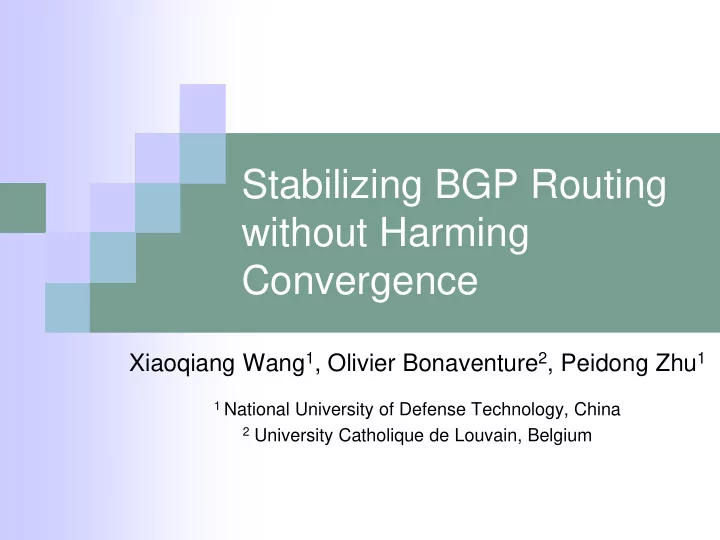

Stabilizing BGP Routing without Harming Convergence Xiaoqiang Wang 1 , Olivier Bonaventure 2 , Peidong Zhu 1 1 National University of Defense Technology, China 2 University Catholique de Louvain, Belgium
Outline Background Motivation Methodology Evaluation Conclusion 2
Outline Background Motivation Methodology Evaluation Conclusion 3
Internet Routing Sprint:1239 Qwest:209 UCLA:52 SBC:7132 Internet B Autonomous System (AS) A : Intra-AS: OSPF, IS-IS, RIP Inter-AS: BGP (Border Gateway Protocol) 4
BGP AS 4 AS 2 AS 7 AS 5 AS 8 AS 1 prefix d AS 6 AS 3 Prefix specific Path Vector Routing Protocol One-fits-all-model 5
BGP Churn Large volume of BGP updates Bad for routers Overload CPU,memory, frequent FIB changes Major causes BGP path exploration Route flapping 6
BGP Path Exploration AS 4 AS 2 AS 7 AS 5 AS 8 AS 1 prefix d AS 6 AS 3 Single event triggers several updates 7
Route Flapping Routes periodically change Reasons are diverse Mice-elephant a significant portion of churn is associated to a small set of highly active prefixes [Rexford 02, Oliveira05] 3% prefixes 36% updates [Pelsser PAM11] 8
Current countermeasures Path exploration acceleration BGP-RCN, EPIC Not deployed yet Suppress excessive BGP updates Route flap Damping, MRAI Only two built-in mechanisms in real router Dying for breaking/delaying convergence 9
Route Flap Damping Principle A penalty per peer and per prefix suppressed time Update penalty upon receiving an update Suppress a route if associated penalty > T Penalty exponentially decays over time Triggered by 3 flaps under cisco parameter [Mao02, Randy02] Interactions between RFD and BGP path exploration 10
MRAI Minimum Route Advertisement Interval Supposed to be per peer and per prefix Rate-limit BGP updates Two consecutive announcements are spaced at least a MRAI interval*jitter[0.75,1] Typical setting: 30s for eBGP, 5s for iBGP BGP updates are heavily delayed 11
Outline Background Motivation Methodology Evaluation Conclusion 12
Motivation(1/2) Analyze BGP change type Data set: one month updates from RouteView Duplicated updates are filtered per prefix Consider only Announcement messages Compare two adjacent updates BGP churn mostly caused by AS_PATH and COMMUNITY changes 13
Motivation(2/2) Path Locality An AS explores limit number of AS_PATHs to reach highly active prefixes Same data set as in previous slide for each prefix, we define locality likelyhood #{𝑢𝑝𝑞 3 𝑞𝑏𝑢ℎ𝑡} 𝑚𝑗𝑙𝑓𝑚𝑧ℎ𝑝𝑝𝑒 = (60,70) #{𝑏𝑚𝑚 𝑞𝑏𝑢ℎ𝑡} Results are similar across 36 monitors 14
Outline Background Motivation Methodology Evaluation Conclusion 15
Basic idea P 1 P 2 P 3 P 2 P 1 P 6 P 7 time t 1 t 2 t 3 t 4 t 5 t 6 t 7 aggregate P 1 and P 2 into P 12 P 12 P 3 P 12 P 6 P 7 time t 1 t 2 t 3 t 4 t 5 t 6 t 7 Conclusion: 2 fewer changes 4 fewer changes if P 3 is further involved 16
Routing issues AS_PATH functions Prevent routing loops, influent BGP decision process Backup path AS 6 and AS 7 are p2p AS 4 AS 2 AS 7 AS 5 AS 8 AS 1 prefix d AS 6 AS 3 17
Solution Per peer and per prefix SSLD(Sender sider loop detection) [Labovitz02] Example To AS 8: [7 4 2 1], [7 5 2 1], [7 6 3 1] Aggregated path is 7{2 3 4 5 }1 To AS 6: [7 4 2 1], [7 5 2 1] Aggregated path is 7{4 5}2 1 18
Workflow Upon receiving a route r regarding p Update the prefix penalty associated to p Update the path penalty associated to r.path Update the path penalty in p ’s history cache If prefix penalty regarding p > threshold AS_PATH aggregation is triggered Clean process is scheduled every T hours Remove those paths whose path penalties are small enough 19
Outline Background Motivation Methodology Evaluation Conclusion 20
Evaluation(1/3) Compared with Path Exploration Damping(PED) [Huston10] Perform better than MRAI with 35 PEDI Metric: reduced updates, convergence duration, convergence delay Performance: better in 29/36 monitors Convergence: better in all monitors 21
Evaluation(2/3) Compared with RFD Metric: reduced updates, involved prefixes Perform better in 21/36 monitors Suppress more prefixes 22
Evaluation(3/3) Memory cost AS_PATH sharing Only upper bound is evaluated At most 5,000 more paths per router Higher ASes buffer fewer AS_PATHs 23
Outline Background Motivation Methodology Evaluation Conclusion 24
Conclusion BGP churn is a problem, especially for those highly active prefixes To utilize path locality is a potential choice Next step is to extend our approach to iBGP so that AS itself can benefit from this technology as well 25
26
Recommend
More recommend